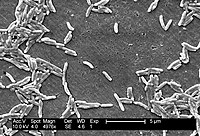Also known as: C. fetus — C. fetus subsp intestinalis
| Campylobacter fetus | |
|---|---|
| Phylum | Proteobacteria |
| Class | Epsilon Proteobacteria |
| Order | Campylobacterales |
| Family | Campylobacteraceae |
| Genus | Campylobacter |
| Species | C.fetus |
Introduction
Campylobacter fetus, has the subspecies fetus and venerealis, belonging to the genus Campylobacter.
C. fetus is the cause of 10% of ovine abortions in the UK. It occassionally causes sporadic abortion in cattle and horses, but at a much lower incidence then in sheep. It can also act in a similar way to C. jejuni and cause enteritis in cattle, sheep, pigs and horses.
The bacteria is an enteric organism of sheep, goats and cattle and is spread by faecal-oral transmission. The ingestion of C. fetus during last trimester of pregnancy causes a bacteraemia. The bacteria can reach the uterus and necrotic placentitis causes late abortion, still birth or weak lambs. Aborted lambs may have round necrotic lesions on the surface of their liver. Aborting ewes are therefore a source of infection for vulnerable animals and up to 20% of a flock may abort.
A solid immunity may be developed. Birds can contribute to the spreading of infection.
Diagnosis
The presence of C. fetus may be diagnosed by:
- hepatic lesions in lambs
- the presence of organisms in the foetal abomasum and isolation and identification of the bacteria.
Treatment and Control
The aborting ewes should be isolated and other ewes should be moved to clean pasture. The placenta should be destroyed and the flock vaccinated with bacterin during the outbreak and prophylactically. During and outbreak, chlortetracycline should be added to the feed.
| Campylobacter fetus subspecies fetus Learning Resources | |
|---|---|
 Search for recent publications via CAB Abstract (CABI log in required) |
Campylobacter fetus subspecies fetus |
